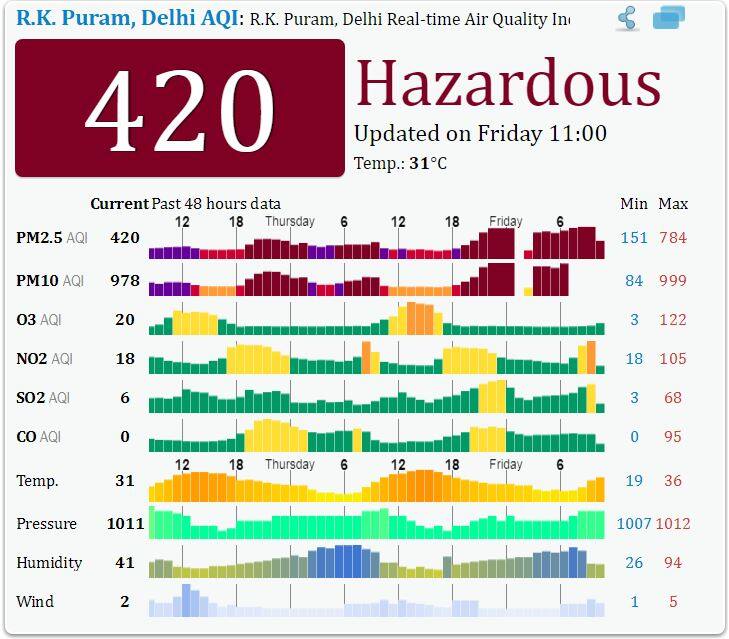



After the festivities are over, Diwali in the national capital is followed by its own set of problems. The drastic increase in air pollution level makes life hell for its residents.
Even this year, despite all efforts by the authorities and a ban on the trade of firecrackers by the Supreme Court, the city woke up to a smoggy morning—keeping up with the trend.
Indicators in the morning of Friday - the next day after Diwali, glowed blood red as air quality was measured as hazardous. This means that anyone who has a prolonged exposure to the air outdoors can fall sick.

The image shows pollutant matter's concentration as reported from RK Puram station of Central Pollution Control Board (CPCB). Source: aqicn.org
In the last three years, the day following Diwali has been more problematic as the hazardous gases and heavy particulate matters linger in the air. The recorded data for the morning after Diwali shows concerning values as the intraday average amount of PM2.5 hover over around 400 micrograms per cubic meter of the air, around seven times the recommended limit of 60 micrograms. One microgram is one-thousandth of a gram.
PM2.5 values indicate the number of particles present in the atmosphere which are less than 2.5 microns. These particles can penetrate our body’s natural security mechanism and can be inhaled deep into lungs, sometimes even reaching our blood. They can cause heart attacks, strokes, lung cancer and respiratory diseases, and are known to pose the greatest risk to human health. According to the World Health Organisation (WHO) measurement of PM2.5 is the best indicator of the level of health risks from air pollution.
Given that, as per WHO, Delhi’s mean PM2.5 level is 122 microgram per cubic metre, the pollution level post-Diwali jumps more than three times as per historical data. The data shows that pollution is almost equal in two different areas with different demographics. Pollution levels reported from Anand Vihar, which more or less represents East Delhi has been equal to the levels reported from RK Puram which is in posh South Delhi. On usual days, RK Puram records lower pollution levels than Anand Vihar, which is a densely populated industrial and transport hub.
This shows the quality of air recorded at 11.30 am on October 20. Source: Berkeley Earth
PM10
The PM10 level, an indicator of coarse particle present in the environment also shoots up post-Diwali. The mean value of PM10 in the air in Delhi is 229 microgram per cubic metre, however, a day after Diwali the level jumps three times as reported from CPCB’s Anand Vihar station. RK Puram recorded a lower level of PM10 level in the last couple of years but still higher than the mean value. According to CPCB, the maximum recommended limit for PM10 is 100 microgram per cubic metre.
Exposure to high concentrations of PM10 can result in a number of health impacts ranging from coughing and wheezing to asthma attacks and bronchitis to high blood pressure, heart attack, strokes and premature death.
NO2
The NO2 level in the air also remains higher than recommended limit a day after Diwali. In 2016, the amount of Nitrogen dioxide present in the air was 143 microgram per cubic metre, way higher than recommended 80 microgram per cubic metre.
Year 2017
For the year 2017, till 2 o’clock, air quality followed more or less its historical trend. The Anand Vihar station reported PM2.5 value at 382 micrograms per cubic metre, whereas RK Puram’s air quality was worse with PM2.5 level at 822 micrograms per cubic metre. PM10 level was also reported to be over 10 times the recommended value.
Also Read: DATA STORY: A dummy's guide to how many cigarettes you 'unwittingly' smoke during Diwali
The level questions the Delhi government’s effort to curb the pollution in the city. The numbers also mock the ban imposed by the Supreme Court. It reflects how shoddily the ban was implemented by the police and the government.
How many cigarettes are we smoking a day after Diwali?
According to an estimate by Richard A Muller and Elizabeth A Muller which was published on Berkeley Earth blog, there are 1.37 deaths every year for every million cigarettes smoked. Applying this to India, which according to an estimate by The Lancet suffers 25 lakh death every year, each one of us is smoking 7.23 cigarettes per day if we are breathing polluted air - which we all are.
This is assuming that PM2.5 value is at 122 microgram per cubic metre which is the yearly mean for Delhi. However, post-Diwali, we are smoking a whopping 22 cigarettes a day if we are breathing outdoors as the level of pollutant is much higher than the usual!
Discover the latest Business News, Sensex, and Nifty updates. Obtain Personal Finance insights, tax queries, and expert opinions on Moneycontrol or download the Moneycontrol App to stay updated!
Find the best of Al News in one place, specially curated for you every weekend.
Stay on top of the latest tech trends and biggest startup news.